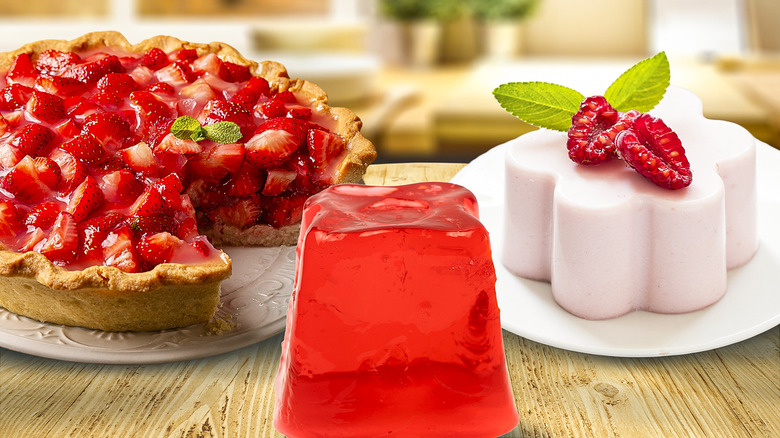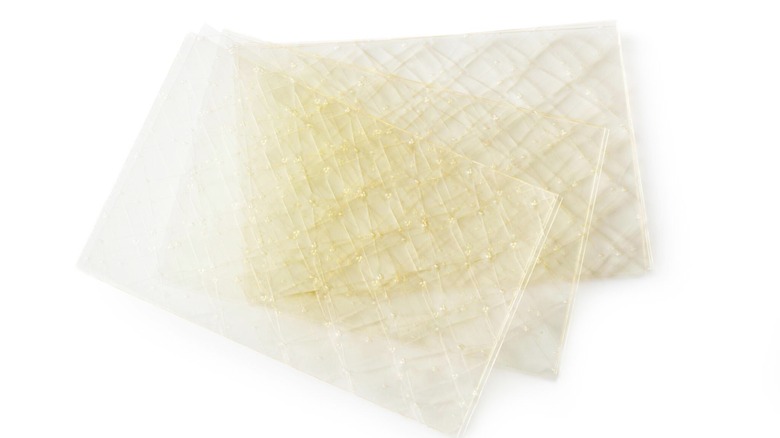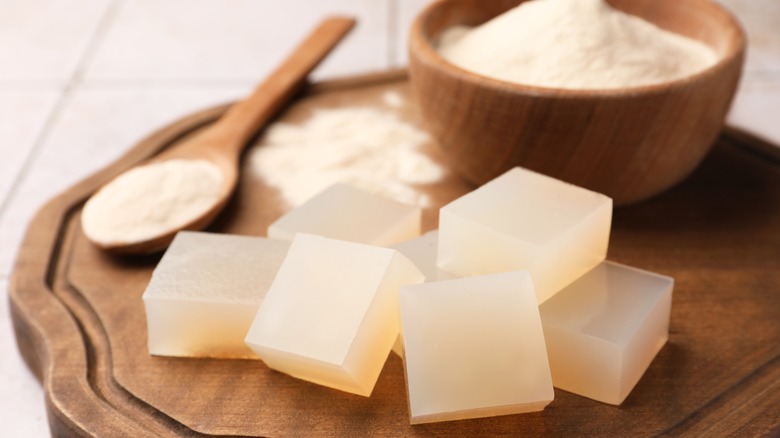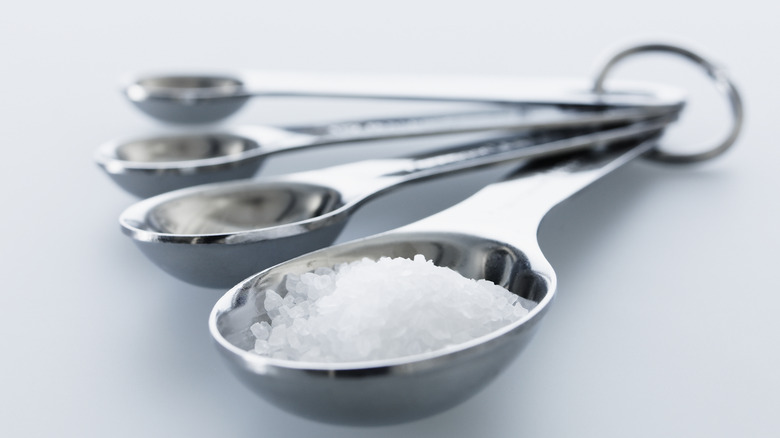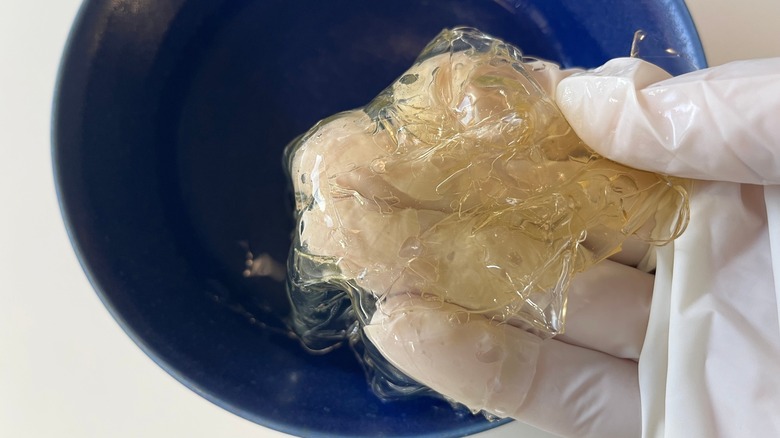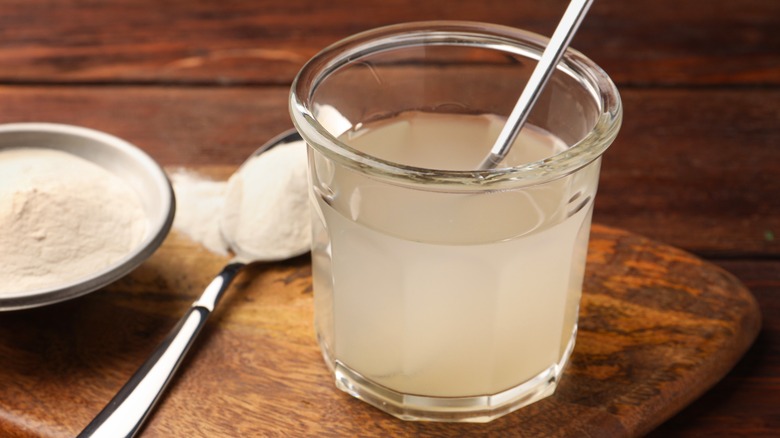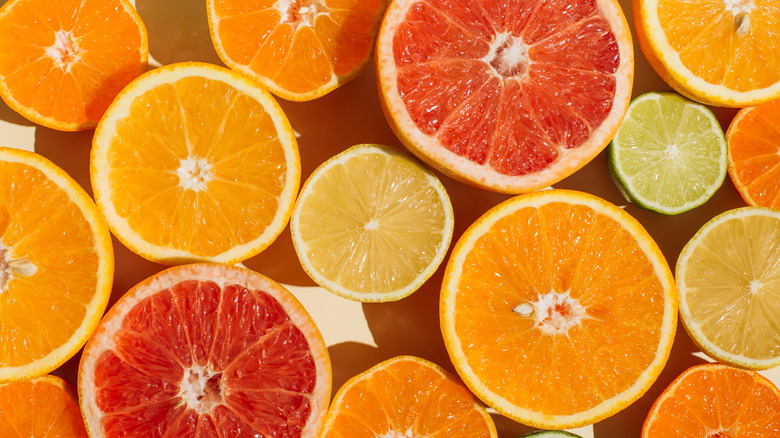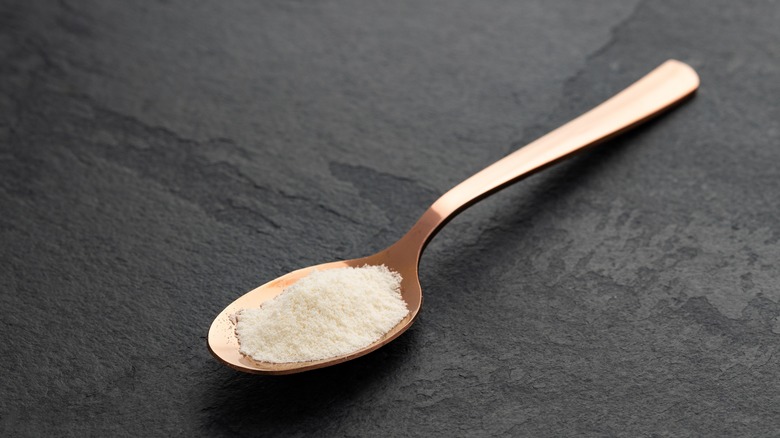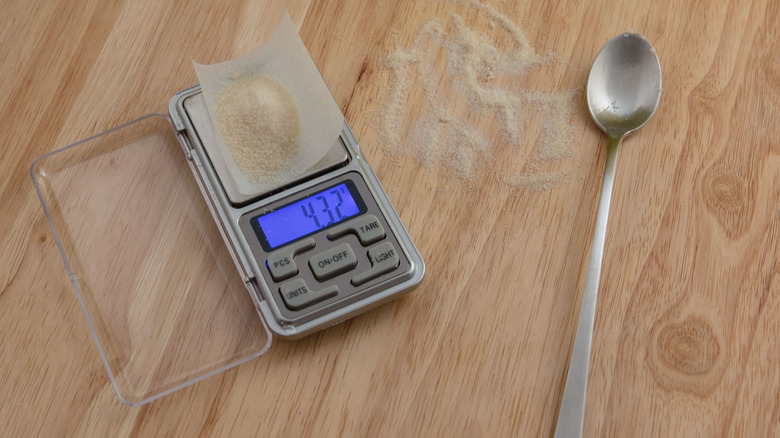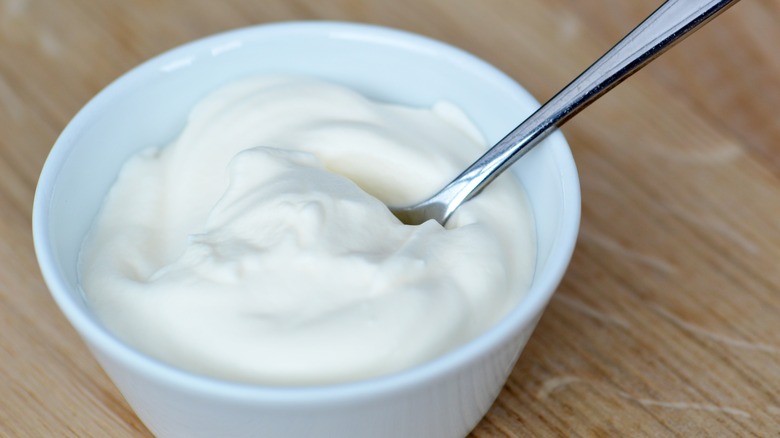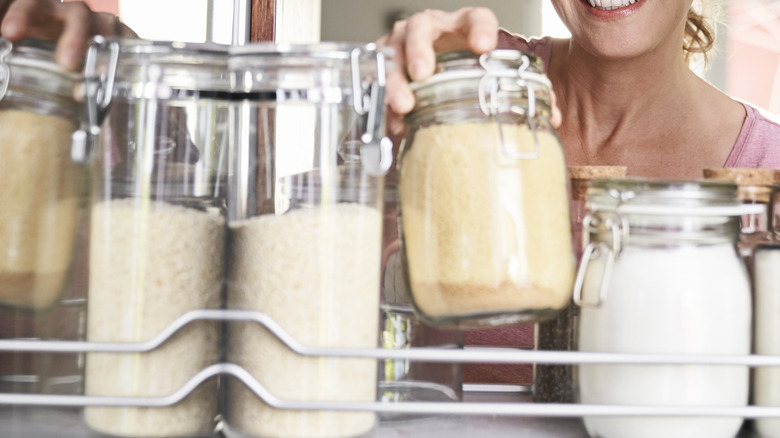The Ultimate Guide For Adding Gelatin To Desserts
If you've ever marveled at the silky smooth consistency of a panna cotta, or the nostalgic joyfulness of a perfectly wobbly jelly, you've seen the magic of gelatin in action. This versatile ingredient is held in high regard in the culinary world for its ability to transform liquid desserts. It is commonly used in professional kitchens to add structure to delicate desserts, but its accessibility and relatively easy means of preparation make it a must-have for any home baker.
However, whilst gelatin is easy to find and can be incorporated into an array of desserts for stabilizing and thickening purposes, alongside providing an attractive sheen, it can be a bit tricky to know how to use it. The very notion of "blooming" can sound a little intimidating, and a general lack of knowledge has put many of us off of using this superstar ingredient. The fact is, gelatin is easy to use and provides impressive results, so there's no reason why you shouldn't have a supply in your pantry.
For expert input on how to use gelatin in your desserts, from what types are available to how to ensure it sets your ingredients properly, we spoke to Gemma Stafford, professional chef, cookbook author, and creator of Bigger Bolder Baking. Stafford's valuable insights provide you with all you need to know about using gelatin in your desserts so that whether it's gooey marshmallows or a perfectly glossy cheesecake, you're set up for success.
Understand the basics
When it comes to adding gelatin to your desserts, a general understanding of the different types and how they are used is key for achieving that ideal texture. If you've never worked with gelatin at all before, knowing where to begin and what to look for can be a little confusing. As Gemma Stafford clarifies, there are two types of basic gelatin: sheet gelatin and powder gelatin. Stafford explains that sheet gelatin "is more commonly used amongst chefs as it creates a very clear gel," which makes it a great option if you're looking to create attractive desserts with an irresistible sheen.
Powder gelatin, on the other hand, also grants a firm and jelly-like texture to desserts in the same way but is a little easier to measure, which may make it a safer choice if you're fairly new to working with gelatin and want to take out any guesswork. Most recipes that call for powdered gelatin will provide the necessary quantities in tablespoons and teaspoons, making it easier to follow and ensuring a greater chance of success. Though you might not get the same crystal clear, glossy finish with powdered gelatin, it lends itself incredibly well to things like marshmallows, where its slight cloudiness has no detrimental impact.
Ultimately, both sheet and powdered gelatin have their unique advantages, so the choice really depends on what you're hoping to achieve and your dessert's specific needs, as well as your overall comfort level in the kitchen.
Choose between animal-based and plant-based gelatin
Generally speaking, powder and sheet gelatin are animal-based, derived from collagen proteins in bone and cartilage. However, as Gemma Stafford notes, there are a number of excellent vegetarian and vegan alternatives to conventional gelatin. "The most popular types of vegetarian-based gels are agar agar or kanten (the Japanese name for this), and carrageenan, aka Irish moss," says Stafford, adding that both are widely available in health food stores, Asian markets, and online, too. Agar agar is a popular thickening and stabilizing ingredient that also lends itself well to recipes that call for egg whites, providing structure and firmness to desserts. Carrageenan, which is also available in numerous varieties, is a particularly popular ingredient, and you're likely to find it on the label of an array of products, from ice cream to soups and sauces, and even baby food.
Both of these plant-based alternatives produce excellent results, and working with them is not too dissimilar from working with their animal-based counterparts — aside from requiring different measurements and a slightly different dissolving process. Thus, you can be assured that choosing them over more traditional non-vegan forms of gelatin does not mean you need to compromise on the consistency of your dessert. Simply choose what works for your lifestyle and specific recipe, and accommodate accordingly for the type of gelatin you plan on using by researching its properties and how it reacts to other ingredients.
Pick the right gelatin for the job
The key to success when adding gelatin to desserts is choosing the right variety for your specific needs. Not only do traditional gelatin and plant-based alternatives have their subtle differences, but the multiple kinds of plant-based gelatins available also boast their own unique sets of properties that make certain types better suited to some purposes than others. As Gemma Stafford told us, iota carrageenan is just one type of carrageenan available, and it is "a great thickening and gelling agent mostly used with fruits and dairy." Kappa carrageenan, meanwhile, "shows stabilizing properties in the presence of milk proteins," making it a popular choice for adding to things like heavy cream and yogurt products. Lambda carrageenan, in contrast to other forms, does not set firm, and thus, Stafford notes is better used as a thickener, commonly used for adding body and thickness to liquid foods.
Agar agar is incredibly easy to work with and has similar properties to conventional forms of gelatin, but it sets a little more firmly, which may mean your desserts are less creamy and have a little less jiggle. Nonetheless, it's an excellent choice if you're looking for easy preparation and a sturdy dessert. If avoiding meat products is not a concern for you, traditional sheet gelatin may be the best bet for a shiny, smooth, and perfectly set finish, and likely is a better choice than a powdered form if you want the dessert you're preparing to be translucent like Jell-O.
Be mindful of plant-based gelatin measurements
Once again, different types of gelatin require different measurements, so it's important to be aware of these differences and accommodate them accordingly to ensure the best results. As Gemma Stafford told us, 1 tablespoon of gelatin will set 2 cups of liquid, and 1 teaspoon of agar powder will set 1 cup of liquid. The two cannot be substituted in exactly the same quantities, and you'll need to take into account how much liquid you are trying to set. Stafford also explained that there are different forms of agar agar, with bars, flakes, and powders all available. For example, 1 teaspoon of agar powder is not equal to 1 teaspoon of agar flakes; you'll want to use 1 tablespoon of agar flakes per teaspoon of powder. If you're working with a bar, this will likely equate to half the bar, but it's worth checking your recipe just to be sure. Carageen, again, is different, with Stafford recommending 1 ounce of dried carrageen for 1 cup of liquid.
Getting to grips with the different measurements may seem confusing at first, but it's worth taking your time to be sure that you're using the correct amount of your specific type and form of gelatin to avoid any disappointing results. Pay close attention to your recipe, as well as any instructions that come with the specific type of gelatin you're using. Don't just assume you can simply use a 1:1 substitute between varieties.
Bloom your gelatin properly
As Gemma Stafford summarizes, "Whether you're using sheet or powder gelatin, you need to 'bloom it,' or bring it to life in a way, before adding it into your recipes." Blooming gelatin is a crucial part of your preparation, as the process enables the gelatin to absorb and hold onto water efficiently, which is essential for achieving that firm and jiggly texture. To get the most out of your gelatin, start by adding the powdered form (or the required amount of sheet gelatin, using your recipe as a guide) to a bowl of cold liquid. Leave the gelatin in the bowl for between three and five minutes, by which time you'll see that the liquid has changed as the powder swells and expands or the sheets soften. Stafford points out that it is a good idea to use plain water for this step if you are adding gelatin to solid desserts, such as cheesecake or mousse, to ensure a smooth texture.
After this initial reaction has taken place and your gelatin is adequately bloomed, you can add it to your recipe. Powdered gelatin may need an extra stir to ensure it is fully dissolved, while sheet gelatin should be gently drained of excess liquid and heated gently until fully dissolved. If you're using agar agar, Stafford notes that to get the most out of it, you'll need to bring it to the boil as part of the blooming process.
Cool it before adding to other ingredients
Although your bloomed gelatin is technically ready to use once it has absorbed your liquid of choice and has changed its structure accordingly, you may not always want to start working with it straight away. As Gemma Stafford told us, if your dissolved gelatin is too hot, it can set in lumps when it comes in contact with your other, colder ingredients. This is especially important to note if you are working with sheet gelatin or agar agar, since a little heat is often part of the dissolving or blooming process. Powdered gelatin, which should be dissolved in cold water, will not need to be cooled down before it is added to other cold ingredients.
To avoid clumping, you could also ensure that the base to which you're adding the slightly warm gelatin is also warm — but leaving it to cool down also allows you to finish other prep in the meantime and also ensures that none of your other ingredients are negatively affected by too much heat.
Avoid acidic ingredients
Gelatin in its many forms is popular in the culinary world for its versatility, but there are nonetheless certain ingredients to avoid when working with it. Gemma Stafford advised against adding gelatin to acidic juices, such as those from fruits like pineapple, kiwi fruit, or mango, as well as citrus juices. The acids in these fruits and their juices break down the structure created by the gelatin, explains Stafford, which can prevent things from setting properly and jeopardize your entire dessert.
Pectin, a similar thickening agent, may be a useful alternative since, as Stafford notes, it is acid-resistant and thus can be added to desserts with fruit juices. However, pectin does not set as firm as gelatin and thus will most likely not deliver the same results, providing instead what Stafford calls a "soft set," which is often used to give structure to things like jams. If you're not after something perfectly sturdy and firm and instead just want to thicken up a fruity dessert, pectin may be a good choice. But, it likely won't fare as well in recipes such as panna cotta, which need to stand up on their own. Decide what kind of consistency you want for your dessert, consider any acidic elements, and choose accordingly based on what you need.
Use a less is more approach
Though it is no doubt useful, too much gelatin can actually be counter-productive. Gemma Stafford succinctly sums it up: "No one wants to bite into a rubbery panna cotta." The key to perfecting your desserts lies in using just the right amount of gelatin, which you should be able to gauge based on the instructions in your recipe and the look and consistency of your dessert. You'll likely aim for a "just set" texture with a slight wobble and (if applicable) a smooth, thick, and creamy texture. When you're measuring out the gelatin, remember that 1 tablespoon of animal-based gelatin can set about 2 cups of liquid, and you can adjust this amount accordingly based on the quantity of liquid you have and the volume of your recipe. Add any more than this, and you may end up with an overly set dessert ... which is hard to redeem.
Not only does adding more gelatin than necessary result in a less-than-desirable texture, but an overly firm and chewy dessert can overshadow more subtle and delicate flavors — an incredibly frustrating result if you've taken the time to perfect the taste of your dessert. Though it might be tempting to add more than is recommended for the sake of ensuring that your dessert sets, it's best to exercise some caution. Keep in mind that achieving the perfect, gently wobbly but stable texture may require a little practice.
Measure ingredients accurately
Much like not using too much gelatin in your dessert, it is important to make sure that you're using the right amount. While too much can result in chewy, overly thick desserts, not adding enough can mean that your dessert doesn't set properly. The last thing you want, after perfecting your flavors and combining all your ingredients, is for your dessert to collapse before you can serve it or not come together in the first place at all. Making sure that your measurements are precise is a sure-fire way to ensure that you are on the best course for success.
As Gemma Stafford told us, one package of powdered animal-based gelatin typically equals 1 tablespoon, and four sheets equals 1 tablespoon of powdered gelatin. It is, however, always worth checking any labels or instructions that come with the specific make and type of gelatin you are using just to be sure. Remember that most plant-based gelatins also have different conversion rates regarding the quantity needed.
Though using tablespoons and teaspoons to measure out your gelatin will likely not cause any mishaps, consider using an electric kitchen scale for greater accuracy. Knowing exactly how many grams you need for your specific amount of liquid, and measuring it precisely with a scale, will reduce further the room for error.
Stabilize whipped cream
Aside from mastering the basics of gelatin and how to use it to set desserts, of equal usefulness is knowing other culinary applications for this ingredient. Amongst these uses is providing structure and stability to whipped cream. As Gemma Stafford puts it, stabilizing whipped cream with gelatin is a "really handy chefs' secret" and is useful if you live in a warm area and struggle to decorate your cakes with whipped cream before the whole thing turns into a dripping mess.
As Stafford told us, to use gelatin as a whipped cream stabilizer, you simply have to bloom it, liquify it, cool it, and slowly stream it into the whipped cream. You'll find that the cream is firmer, adaptable, and more able to hold its shape, meaning you can swirl and stack it on top of cakes for decoration without worrying about any peaks drooping. A whipped cream topping prepared in this way makes a fantastic alternative to sweeter, denser alternatives like buttercream and can be used to create truly beautiful and eye-catching desserts with impressive height. So, even if you don't plan on making marshmallows or panna cotta any time soon, there's still an excellent reason to keep gelatin in your pantry.
Store gelatin correctly
Much like is the case with most ingredients, both fresh and ambient, storing gelatin properly is crucial for ensuring both its effectiveness and longevity. Unused gelatin, both sheet and powdered forms, has a considerably long shelf life and will likely last until you've used it all up so long as it is stored correctly. It should be kept in an airtight container and housed in a cool, dry environment, away from any sources of moisture, because of its absorbency. Gelatin also has a propensity to absorb strong odors, so it's best to keep it stored in a separate area from ingredients like coffee, if possible.
Most desserts that are made with gelatin require refrigerating to retain their texture and benefit from a cover to prevent a skin from forming on top. However, as Gemma Stafford points out, desserts made with agar agar may not need the same treatment. Agar agar, she explains, stays firm even in high temperatures, so on hot days, you don't have to worry that your dessert will collapse. Naturally, though, desserts that are made with dairy should be kept in the refrigerator to keep them fresh.
